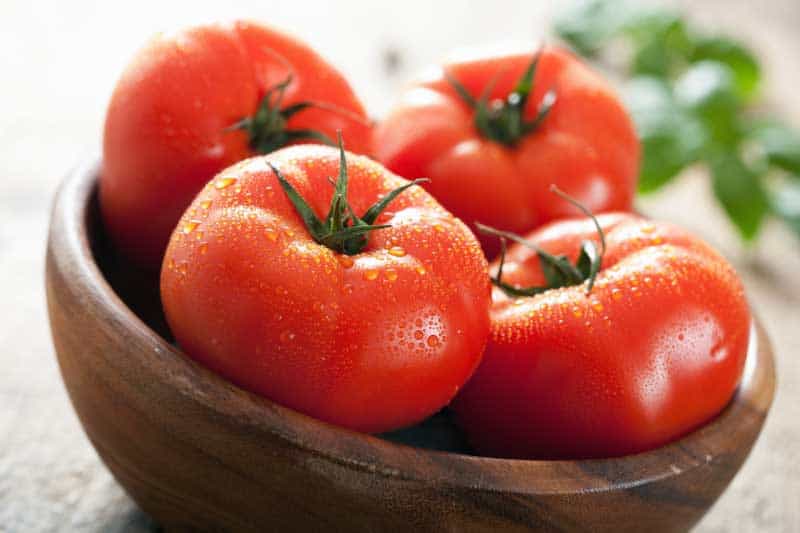There are few semantical debates that are more popular than labeling tomatoes as a fruit or vegetable. Fruit advocates point to the seeds of a tomato as sufficient proof that the crop should be labeled a fruit, while vegetable apologists claim that tomatoes simply do not have the flavor profile of a fruit. The real answer is a little more nebulous than these rigid contentions.
A tomato is both a fruit and a vegetable. If you are classifying a tomato as a botanist, you would likely claim that a tomato is a fruit. However, if you are a nutritionist or chef, then you would generally classify tomatoes as a vegetable.
This may not be the answer that satisfies devout advocates on either side, but it is the best answer we have on the classification of this South American crop. Keep reading to learn more about the thought process regarding its classification as both a fruit and a vegetable.
The Argument for Tomato as a Fruit
The major proponents for hailing tomato as a fruit are botanists. Botanists classify tomatoes as fruits using the same methodology for classifying any other crop as a fruit. This methodology is based on the physiological characteristics of a crop, such as its structure, function, and organization.
There is actually a vast range of fruit classifications that consider these physiological characteristics when making a classification. These classifications are split into two broad categories, fleshy fruits, and dry fruits. Let’s take a look at the classifications for fruits that fall into the category of fleshy fruits.
- Drupes: The signifying characteristic of a drupe is a single seed, typically referred to as a pit, surrounded by a bony endocarp, the innermost layer of fruit. Examples of fruits that fall under the drupe classification are plums, peaches, and olives.
- Berries: This classification of fruits is signified by the presence of several seeds and a particularly fleshy pericarp, the layers of a fruit surrounding the seed(s). Examples of fruits that fall under the berry classification include grapes, eggplants, and tomatoes.
- Pomes: This classification of fruits is signified by the presence of many seeds with a sweet and juicy tissue surrounding the fruit’s pericarp. Examples of fruits that fall under the pome classification include apples and pears.
- Hesperidia: The signifying characteristic of hesperidia fruits are their leathery rinds and citrus flavor profile. Examples of fruits that fall under the hesperidia classification include lemons, limes, and oranges.
- Pepos: This classification of fruits is also signified by their leathery rinds, but none of these fruits feature a citrus flavor profile. Examples of fruits that fall under the pepo classification include cucumbers, cantaloupes, and squash.
Now, let’s take a look at the classifications for fruits that fall into the category of dry fruits.
- Follicles: Follicle fruits are pod-like and contain many seeds. Examples of fruits that fall under the follicle classification are milkweed and magnolia pods.
- Legumes: Legume fruits are also pod-like but open along two sides and contain fewer seeds. Examples of fruits that fall under the legume classification are peanuts, peas, and beans.
- Capsules: Capsule fruits open along three or more lines at the top of the fruit to release their seeds. Examples of fruits that fall under the capsule classification are lilies and poppies.
- Achenes: Achenes contain just a single seed, and an anchoring anatomical part called the funiculus. A popular example of achenes fruit is the sunflower seed.
- Nuts: Nuts feature hardened fibrous pericarps and are composed of a compound ovary. Examples of fruits that fall under the nut classification are acorns, hickory nuts, and hazelnuts.
- Samaras: Samara fruits contain a flattened wing-like structure on their pericarps. Examples of fruits that fall under the samara classification are ash and elm trees.
- Schizocarps: Shizocarp fruits are composed of two parts that split into single-seeded portions. A common example of a schizocarp fruit is the fruit produced from maple trees.
- Caryopses: Caryopsis fruits contain a single seed which is adhered to the fruit’s pericarp. Examples of fruits that fall under the caryopsis classification are wheat, corn, rice, and oats.
Using this list of fruit classifications, it is clear that tomatoes fall under the berry classification, which is a subsect of all fleshy fruits. This classification is generally not disputed, but it is not always what people place the most importance on when referring to the differences between fruits and vegetables.
The Argument for Tomato as a Vegetable
The scientific classification of tomatoes may be fruit, but professionals in a different industry have a different system for classification. These professionals, typically nutritionists and chefs, use the culinary classification system, which dictates that tomatoes are, in fact, vegetables. Here is a list of the facets that are factored into the culinary classification system.
- Flavor Profile
- Texture
- Typical Usage
The culinary classification system focuses more on a crop’s flavor profile, texture, and typical usage. When defining vegetables, the culinary classification system describes crops that feature a rougher texture and blander flavor profile. Additionally, vegetables will typically be used in meals such as stews, soups, and stir-fries.
Tomatoes can be difficult to classify when only looking at their texture and flavor profile. Tomatoes can be a little sweet, and their texture is certainly not rough. However, the typical employment of tomatoes in savory dishes is what leads most nutritionists and chefs to classify the crop as a vegetable.
The Great Tomato Debate
A common misconception on the tomato is that the crop was once incorrectly classified by botanists as a vegetable before being corrected to be a fruit. The tomato was always botanically classified as a fruit. However, classifications of the tomato from other sources often chose to classify the tomato as a vegetable.
The origins of this tomato-as-a-vegetable classification can be found in an obscure 19th-century Supreme Court case, Nix v. Hedden (1893). This Supreme Court case concerned tomatoes that were imported to America from the West Indies in 1886.
These tomatoes came with a 10-percent tariff, which was instituted by the tariff act of 1883, which enforced a 10-percent tax on all vegetables. The plaintiff, John Nix, sought to dispute this tariff because tomatoes were botanically classified not as vegetables but as fruits.
He originally filed this case in 1887, and it eventually made it all the way to the United States Supreme Court in 1893. However, the court ruled against John Nix, contending that tomatoes are neither prepared nor consumed like fruits, so they should be not be classified as fruits.
Justice Horace Gray further explained this decision, contending that, although tomatoes are indeed botanically classified as fruits, the common language of the American people dictates that tomatoes are vegetables. This case became an integral factor in future trade agreements, even influencing the League of Nations to classify tomatoes as vegetables 44 years later.
Beyond its trade implications, the Nix v. Hedden (1893) case greatly influenced public perception of the crop. Although tomatoes were already commonly referred to as vegetables, as mentioned in Justice Horace Gray’s ruling, this case legitimized this association.
This perception lingered for quite a while in American popular culture, but recent legal declarations, beginning in Europe, have begun to shift this perception. In 2001, the European Union issued a directive that classified tomatoes as fruits. Although United States law still upholds the 1893 Nix v. Hedden case ruling, this directive sparked a shift in perception.
Final Thoughts
Ultimately, the answer to whether or not tomatoes are a fruit or a vegetable simply resides in whether or not you adhere more to the professional opinion of botanists or culinary experts.

